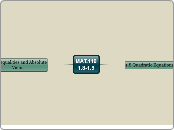作者:David Kedrowski 14 年以前
409
MAT.116 1.8-1.9
The text discusses the concepts of inequalities and absolute value, detailing the various ways intervals can be represented, including finite, infinite, open, closed, and half-open intervals.

作者:David Kedrowski 14 年以前
409

更多类似内容
If a and b are any real numbers, then
The absolute value of a number a is denoted by |a| and is defined by
|a| = { a if a>=0
{ -a if a < 0
Absolute value represents the distance a real number is from 0 on the number line. Absolute value is always nonnegative.
A graphing calculator is a good tool to assist with the solution of nonlinear inequalities.
A real number is a solution of an inequality in one variable if a true statement is obtained when the variable is replaced by that number.
The set of all real numbers satisfying the inequality is called the solution set.
Solution sets for inequalities in one variable can be written in inequality notation, set notation, and interval notation, and they can be graphed on a number line
Let a, b, and c be any real numbers.
These properties are also true for >, >=, and <=.
< less than (strictly less than)
> greater than (strictly greater than)
<= less than or equal to
>= greater than or equal to
Equivalent symbols:
Finite
Infinite
Finite intervals
Open intervals
Closed intervals
Half-open intervals
Infinite intervals
The disciriminant of the quadratic equation is
b^2 - 4ac.
If the discriminant is positive, the equation has two distinct real solutions.
If the discriminant is zero, the equation has one real solution.
If the disciminant is negative, the equation has no real solutions.
Given a quadratic equation in standar form,
ax^2 + bx + c = 0 (a not zero),
we can solve the equation using the quadratic formula
-b +- sqrt( b^2 - 4ac )
x = -------------------------
2a
Begin with the quadratic equation in standard form
ax^2 + bx + c = 0
Rewrite the equation into the equivalent form
x^2 + (b/a)x = -(c/a)
Add (b/2a)^2 to both sides of the equation
x^2 + (b/a)x + (b/2a)^2 = -(c/a) + (b/2a)^2
Factor the left side into a perfect square and add the right-hand side togther
(x + b/2a)^2 = (b^2 - 4ac) / 4a^2
Use the square root principle and solve for x
x + b/2a = +-sqrt((b^2 - 4ac) / 4a^2)
x = -b/2a +- sqrt((b^2 - 4ac) / 4a^2)
Zero-Product Property of Real Numbers:
If a and b are real numbers and ab=0, then a=0, or b=0, or both a,b=0.
A quadratic equation in one variable can be written in the form ax^2+bx+c=0 (a not zero). This is called standard form.